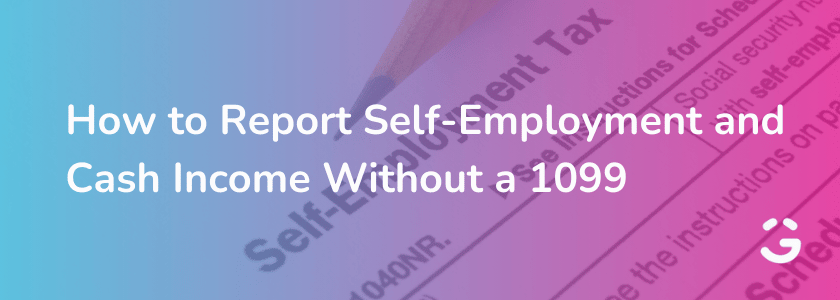In the gig economy, more and more people are embracing self-employment. Whether you're a freelancer, consultant, or run a small business, you might find yourself receiving income without the traditional 1099 form.
So, what do you do when you have self-employment or cash income that doesn't come with a 1099? In this guide, we'll explore how to report self-employment income without a 1099 to stay compliant with tax regulations while enjoying the flexibility of freelance work.
Understanding Self-Employment Income and the 1099 Form
Before we get into the nitty-gritty of reporting self-employment income without a 1099, let’s first understand what self-employment income is and what the 1099 form represents.
Self-employment income is money earned by individuals who work for themselves rather than for an employer. This can include freelance work, consulting, gig economy jobs, and small business earnings. It's important to note that when you're self-employed, you're responsible for accurately reporting your income to the IRS.
This is where the 1099 form comes in. It serves as a reporting tool for businesses that allows them to document diverse income streams paid to self-employed professionals and independent contractors.
While different types of 1099 forms exist, you’ll most likely deal with the 1099-MISC. It’s the go-to form for reporting money you earn when you work for yourself or do freelance gigs.
When Should You Receive a 1099?
If you're self-employed and earned $600 or more from a client or business during the tax year, they should issue you a 1099 form. However, not all clients or businesses follow this rule, and that's where the challenge lies. Many self-employed individuals find themselves with income that hasn't been reported on a 1099.
How to Report Self-Employment Income Without a 1099 Form
There are times when you may not receive a 1099 even if your earnings surpass the threshold. This can happen for various reasons. For instance, the client or company you worked for might have made an oversight. Regardless of the reason, the responsibility to report your income remains with you. Simply follow these steps to do so:
Keep Accurate Records
When you're self-employed, keeping accurate income records is a must. Since you may not always receive a 1099 form from clients or customers, it's up to you to track your earnings. This includes invoices, receipts, bank statements, and other documentation.
Create a system that records all payments, whether through checks, cash, or digital transactions. This not only helps you prove your income as a freelancer and report your income accurately but also provides a clear picture of your financial health.
Determine your Total Income
Once you have your records in order, calculate your total self-employment income. This should include all payments you've received for your services, whether they were reported on a 1099 or not. Aim for accuracy to ensure you comply with IRS regulations.
File a Schedule C
When filing their tax returns, the IRS requires self-employed individuals to report their income on Schedule C (Profit or Loss from Business). If you didn't receive a 1099, you will need to include all your income on this form. List each client or source separately, along with the total income received from them.
Deduct Business Expenses
One of the perks of being self-employed is your ability to deduct legitimate business expenses from your total income. These deductions reduce your taxable income, ultimately lowering your tax liability.
Common deductions include expenses related to your home office, supplies, equipment, and mileage. Ensure you keep detailed records of these expenses as well.
Pay Self-Employment Taxes
To calculate your self-employment tax, you can use Schedule SE (Self-Employment Tax) attached to your tax return. It's important to factor this into your overall tax planning, as it can significantly affect your tax liability.
Submit your Tax Return
After filling out Schedule C and Schedule SE, the next step is to merge these documents with your individual tax return. Make sure your tax reaches the IRS by the designated tax filing deadline, commonly set on April 15th. In case you require an extension, it's possible to request one. However, it's crucial that you settle any outstanding taxes by the original deadline.
Reporting Cash Income Without a 1099
Cash income is a bit trickier to handle, primarily because it often doesn’t leave any paper trail. However, that doesn’t exempt you from reporting it. Here’s how to report cash income without 1099:
Keep a Cash Log
The importance of keeping thorough records can't be emphasized enough. Record each payment you receive in cash, including the date, source, and amount. This log will serve as a valuable record when it's time to report your income.
Separate Business and Personal Finances
It's a smart move to keep your personal and business finances separate. Have a dedicated business bank account to deposit all your cash income and make business-related expenses. This practice not only simplifies your record-keeping but also demonstrates your commitment to being a legitimate business.
Report Cash Income on Schedule C
Similar to non-cash income, you'll report your cash income on the Schedule C form. Be transparent about all your earnings, even the ones in cash. The IRS takes underreporting seriously, and it's best to avoid any complications by being honest.
Explain Discrepancies
If your reported income doesn't align with the records the IRS may have on file (for example, if a client reports a payment to you), be prepared to explain any discrepancies. Having clear, organized records will work in your favor in such situations.
Final Thoughts
Reporting self-employment and cash income without a 1099 requires diligence and accuracy. By keeping precise records, filing a Schedule C, and reporting all sources of income, including cash payments, you not only comply with tax regulations but also safeguard your financial future.
Don't let the absence of a 1099 form be a stumbling block. Take the first step towards financial peace of mind by taking control of your self-employment income reporting today!
